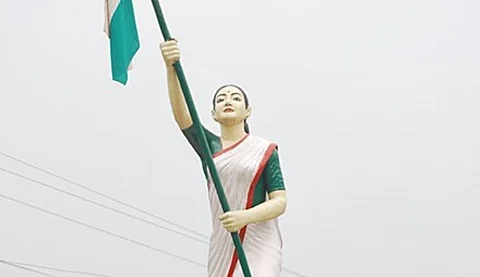
- Home
- Live Blog
- Breaking News
- Top Headlines
- Cities
- NE News
- Sentinel Media
- Sports
- Education
- Jobs

Satyabrat Borah (satyabratborah12@gmail.com)
Kanaklata Barua was a young and fearless freedom fighter whose name has become identical with bravery and patriotism during India’s struggle for independence. Born on December 22, 1924, in the remote Borangabari village of Assam, Kanaklata hailed from a humble family. Although she lost both her parents at a young age, she grew up with a strong sense of responsibility and patriotism, qualities that would eventually lead her to become a martyr for the nation.
Despite the adversities in her early life, Kanaklata displayed an indomitable spirit and fierce love for her country. As a child growing up in colonial India, she was deeply influenced by the ongoing freedom struggle. India was reeling under British oppression, and the atmosphere was charged with revolutionary ideas. Like many youths of her time, Kanaklata was inspired by the sacrifices of great freedom fighters such as Mahatma Gandhi, Subhas Chandra Bose, and local Assamese leaders like Kushal Konwar.
Though she was very young, Kanaklata was deeply inspired by the growing call for independence. She realised that the freedom movement was not limited to prominent leaders but was something that every Indian citizen could and should participate in. Her patriotism became evident in the way she engaged with the political movements of her time, despite societal restrictions imposed on women.
In 1942, Mahatma Gandhi launched the Quit India Movement. It’s a call for immediate British withdrawal from India. The movement spread like wildfire across the nation. It mobilises masses of Indians to rise against colonial rule. This was a critical moment in India’s freedom struggle. It witnessed the active participation of people from all walks of life, including women and the youth.
Kanaklata joined the movement with unwavering resolve, though she was only 17 years old. She was a part of the ‘Mrityu Bahini,’ which is a group of young revolutionaries in Assam who were ready to sacrifice their lives for the country’s independence. “Mrityu Bahini” symbolised the undying spirit of Indian youth, who were willing to face any hardship in their quest for freedom.
Kanaklata’s most heroic and tragic act came on September 20, 1942, when she and her fellow revolutionaries in the Mrityu Bahini decided to hoist the Indian national flag at the British-controlled police station in Gohpur, Assam. This act of rebellion was meant to send a clear message to the British authorities that the Indian people would no longer bow to colonial rule.
They were ready to take bold steps to declare their independence.
Led by Kanaklata and Mukunda Kakati, the group marched towards the police station by holding the tricolour with pride and determination. The British authorities already sensed the symbolic power of this act and ordered them to stop. But Kanaklata refused to turn back. Despite the warnings, she continued to march forward with the national flag in hand.
The British police opened fire when the revolutionaries refused to halt. Kanaklata was one of the first to be shot. She died instantly by holding the tricolour close to her heart. Despite her death, the flag was kept aloft by her fellow revolutionaries. They continued their protest, unwilling to let her sacrifice be in vain.
Kanaklata Barua’s sacrifice expanded far beyond the borders of Assam. It inspired many to join the freedom struggle. Her act of bravery, particularly her willingness to lay down her life for the nation at such a young age, became a symbol of the selfless spirit of India’s freedom fighters.
Her patriotism also highlighted the crucial role of women in the freedom movement. At a time when society placed significant restrictions on women’s public and political participation, Kanaklata shattered those barriers with her bold actions. Her story became a source of inspiration, particularly for women, showing that they too had a vital role to play in shaping the destiny of the nation.
Kanaklata Barua’s name is preserved in the records of Indian history as a fearless patriot. The Government of India and the state of Assam have honoured her in numerous ways. Her martyrdom is commemorated annually in Assam. Her story is taught in schools to remind younger generations of the sacrifices made by her for India’s freedom. The Indian Navy named a fast patrol vessel INS Kanaklata Barua in her honour, recognising her contribution to the independence movement. Her heritage is also celebrated in popular culture, where she is remembered as a symbol of courage.
The story of Kanaklata is one of unparalleled bravery and selflessness. Despite her young age, she exhibited a deep understanding of patriotism and the importance of fighting for her own country. Her ultimate sacrifice during the Quit India Movement is a reminder that the freedom India enjoys today came at the cost of countless lives like hers.
In a world where the struggles of youth and women were often overlooked, Kanaklata broke barriers, standing tall as a leader who fearlessly confronted injustice. Her unwavering commitment to India’s independence continues to inspire generations, making her a timeless symbol of bravery and patriotism.